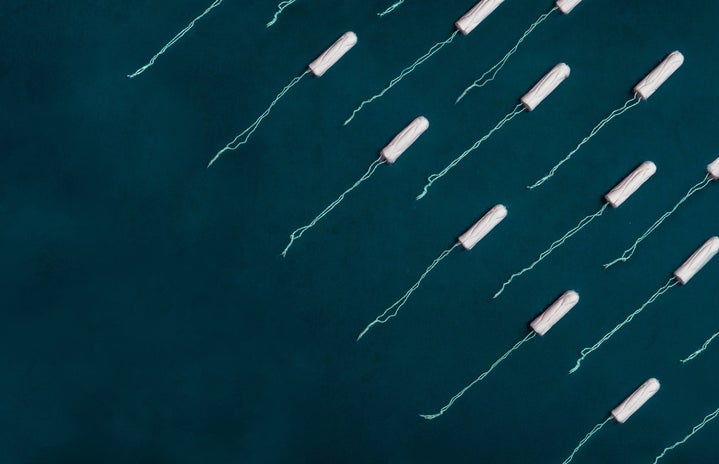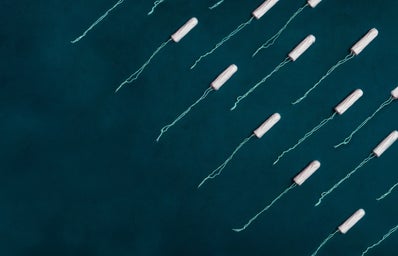Nature’s monthly gift is far from luxurious. You may not exactly feel ready to tackle the day when you’re curled up in a ball in your bed with a heating pad crying over Grey’s Anatomy re-runs.
The last thing you should have to worry about when you’re dealing with killer cramps or a bad period headache is whether or not the products you’re using are harmful to your health. With scary articles going viral (who can forget about the one about a woman who decided to sue a tampon company a few years ago?), it’s hard not to be a little concerned.
In order to get all of the facts straight, here’s some answers to common questions college students might have about tampons.
What’s even in a tampon?
The FDA notes that tampons sold in the United States are made out of cotton, rayon or blends of both ingredients. The FDA says rayon “is made from cellulose fibers derived from wood pulp,” and is bleached during the process. The method used to treat the wood pulp is completely safe and is chlorine-free.
Before this recent data was released, previous information noted that the wood pulp bleaching process was a possible breeding ground for a chemical compound called dioxin. A different method is used today, which significantly reduces the amount of dioxin found in tampons.
Betsey Miller, a certified nurse practitioner at Messiah College, notes that trace amount of dioxin present in tampons is harmless. “Dioxin is present in tampons, but only in trace amounts, so it isn’t significant enough to be harmful,” she says. “It also will not raise your risk of toxic shock syndrome, since the two are not related.”
I heard a rumor about tampons containing asbestos. True or false?
Just like rumors have spread about harmful amounts of dioxin being present in tampons, false news has been released about tampon manufacturers adding asbestos to tampons.
According to WebMD, asbestos is “a group of minerals with thin, microscopic fibers.” Many products in the automotive and construction industries contain asbestos, but when the products are disturbed, the tiny fibers can be released into the air, which can harm the lungs.
When we asked Miller about asbestos in tampons, she confirmed that they are not present in tampons, so you don’t have anything to worry about when it comes to asbestos and tampon usage.
Is there any relation between tampon ingredients & toxic shock syndrome?
Toxic shock syndrome, commonly referred to as TSS, is a very rare but serious disease commonly caused by staph bacteria. You may have heard about TSS in health class or read about it in the booklet that comes with every box of tampons.
It’s important to note that TSS is a disease that can affect men, children and postmenopausal women, not just people who menstruate. A common issue that can bring forth the symptoms of TSS is tampon absorbency. An easy way to lower your risk for TSS is to make sure that you monitor the absorbency of your tampon throughout your cycle based on your flow.
Miller says that “TSS is related to how often you leave your tampon in, rather than the ingredients in the tampon itself.” Going back to what she mentioned earlier about tampon ingredients, she reiterated that the actual ingredients of tampons are not a risk factor for people, as they are constantly approved and monitored by the FDA.
Speaking of TSS … how can I prevent that?
To stay healthy and avoid the trauma that comes with removing a tampon too early, make sure you are using lower absorbency tampons and that you are changing them often. This time range is usually between four and eight hours, but you may need to change one earlier than necessary during the first few days of your period.
Miller also says that you should never sleep with a tampon in or leave one in for more than eight hours, since it can increase your risk for bacterial infections and other preventable problems.
What’s the difference between organic and regular tampons?
The battle between regular and organic tampons is more of a matter of preference rather than one of health concern. Both types of tampons will absorb your flow in the same way and both are safe to use.
According to Miller, the “all-natural” and “organic” labels do not necessarily mean “better.” It brings a higher level of comfort to many women, but can often just be a marketing tactic. Many tampon manufacturers list the ingredients of their tampons on their websites, so if you want to learn more about specific ingredients between different brands, you can easily find out.
With this relevant and current tampon knowledge under your belt, you’ll be able to handle your period with extra confidence and security. Now, pass the chocolate!

